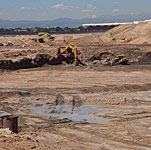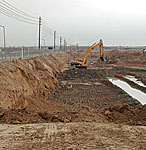An Abandoned Airport Brownfield Takes Off
Getting dirty
The brownfield remediation at Stapleton occurred under Colorado's voluntary program. Prior to Forest City Stapleton's involvement on-site, following a competitive bid process the city and county engaged Parsons, the international engineering giant, in a contract to clean the site's soil and groundwater contamination. Although the city was aware of the obvious polluted sites, such as the aircraft refueling and maintenance areas, the contract included the directive to conduct soil and groundwater testing throughout the acreage. Tom Wood, Parsons's project manager for Stapleton and an environmental engineer with over 27 years experience in brownfield remediation, said it wasn't unexpected to find additional contamination on such a large site, which has led to an increased scope.
It's no surprise the major contaminant present at Stapleton was jet fuel, as well as glycol for deicing purposes and aviation fuel (AV fuel) used for smaller planes. The contaminants one looks for in the ground for these various chemicals differ greatly: For jet fuel, one would look for petroleum hydrocarbons and, in some cases, chlorinated hydrocarbons; glycol contains polypropylene and ethanol; and AV fuel, which is lighter than jet fuel, contains mostly benzene.
Parsons began the remediation process by drilling thousands of wells across the site. Where they discovered large plumes, such as at each concourse, they mapped them and plotted their trajectories through the site. More often than not, the contaminants followed logical underground routes, either along existing groundwater channels, such as the two natural creeks on-site, or along pipelines that provided easy distribution networks for liquids. The fire hydrant system, for example, consisted of a pipeline complex packed in porous gravel, as serviceable a flume for contaminated water as any.
Spilled fuel sinks through the topsoil and eventually comes to rest floating on the water table, which is between 20 and 25 feet beneath the ground across the airport. Parsons used a conventional direct-push drilling technology mounted on a hydraulic rig on a pickup truck. The drill pushes a 1-inch diameter hollow rod into the ground and exhumes a 3¼4-inch core of soil for examination. Wood said it was relatively easy to see contamination in the field because jet fuel leaves an obvious "smear zone" of oily, black residue along the water table, similar to the ring around a dirty bathtub.
Geologists on-site paid particular attention to soil grain size as a chief indicator of conditions that would suggest an underground stream or sand channel where contaminants were likely. While visual analysis and smell provided basic evidence, Parsons utilized an infrared spectrophotometry screening method, a standard testing procedure regulated by the EPA, that would determine the amount of petroleum hydrocarbons in the soil to within 100 parts per million. While samples were sent off-site to a lab for more precise testing, Wood said it could take up to five days for results. In order to meet the schedule for turning over clean land for development, field testing was considered thorough enough to bracket off contaminated areas in order to proceed with remediation.
Â











